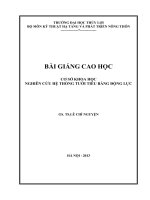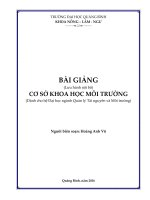Bài giảng Cơ sở khoa học của biến đổi khí hậu (Đại cương về BĐKH) – Phần II: Bài 4 – ĐH KHTN Hà Nội
Bạn đang xem bản rút gọn của tài liệu. Xem và tải ngay bản đầy đủ của tài liệu tại đây (8.6 MB, 14 trang )
VNU HANOI UNIVERSITY OF SCIENCE
REGIONAL CLIMATE MODELING AND CLIMATE CHANGE
CƠ SỞ KHOA HỌC
CỦA BIẾN ĐỔI KHÍ HẬU
(Đại cương về BĐKH)
Phần II
----------------------------------------------------------Phan Van Tan
B04: Bề mặt đất, Đại dương và khí hậu
Bài 1: Các thành phần của hệ thống khí hậu
Bài 2: Sự truyền bức xạ và khí hậu
Bài 3: Hồn lưu khí quyển và khí hậu
Bài 4: Bề mặt đất, Đại dương và khí hậu
Bài 5: Lịch sử và sự tiến triển của khí hậu Trái đất
Bài 6: Khái niệm về Biến đổi khí hậu
Bài 7: Tác động bức xạ và BĐKH
Bài 8: Biến đổi trong các thành phần của hệ thống khí hậu
Bài 9: Biến đổi của các hiện tượng cực đoan
Bài 10: Giới thiệu về khí hậu Việt Nam
Bài 11: Biến đổi khí hậu ở Việt Nam
Bài 12: Mơ hình hóa khí hậu
Bài 13: Dự tính khí hậu
Bài 14: Xây dựng kịch bản BĐKH
Bài 15: Tác động của BĐKH và tính dễ bị tổn thương do BĐKH
Vai trị của bề mặt đất và khí hậu
| Lớp bề mặt đất:
{ Là một lớp mỏng phía trên: Vài mét trên cùng
{ Lớp phủ bề mặt: Thực vật, băng tuyết, tính chất đất
| Các dịng trao đổi bề mặt đất – khí quyển
{ Năng lượng, khối lượng, nước
{ Phụ thuộc cấu trúc lớp bề mặt và điều kiện khí quyển
| Ảnh hưởng đối với khí hậu
{ Biến đổi sử dụng đất: Thay đổi độ gồ ghề, albedo, nước trong
đất,…
| Biến đổi đất sử dụng và biến đổi khí hậu
Deep water: high wind, high altitude
10–20
12
Moist dark soil, high humus
5–15
10
Moist gray soil
10–20
15
Dry soil, desert
20–35
30
20–30
25
BARE SURFACES
Albedo bề mặt
102
TABLE 4.2
Wet sand
102
4. THE ENERGY BALANCE OF THE SURFACE
Dry light sand
Albedos for Various Surfaces in Percent
Surface type
Range
Typical value
4. THE ENERGY BALANCE OF THE SURFACE
30–40
35
Asphalt
5–10
TABLEpavement
4.2 Albedos for Various Surfaces in Percent
7
Concrete
pavement
Surface type
15–35
Range
20
Typical
value
WATER
VEGETATION
WATER
Deep water: low wind, low altitude
5–10
7
Deepgreen
water:vegetation
low wind, low altitude
Short
5–10
10–20
717
Deep water: high wind, high altitude
10–20
12
10–20
20–30
12
25
BARE SURFACES
Deep
water: high wind, high altitude
Dry
vegetation
BARE SURFACES
Coniferous forest
10–15
12
Moist dark soil, high humus
5–15
10
Moist darkforest
soil, high humus
Deciduous
5–15
15–25
10
17
Moist gray soil
10–20
15
Moist gray
SNOW
ANDsoil
ICE
10–20
15
Dry soil, desert
20–35
30
Wet sand
20–30
25
Dry light sand
30–40
35
Asphalt pavement
5–10
7
Concrete pavement
15–35
20
Dry soil, desert
Forest with surface snow cover
Wet sand
Sea ice, no snow cover
Dry light sand
Old, melting snow
Asphalt pavement
Dry, cold snow
Concrete pavement
Fresh, dry snow
VEGETATION
20–35
20–35
20–30
25–40
30–40
35–65
5–10
60–75
15–35
70–90
30
25
25
30
35
50
7
70
20
80
10–20
17
10–20
17
Forest with surface snow cover
20–35
25
Sea ice, no snow cover
25–40
30
Old, melting snow
35–65
50
VEGETATION
Short green vegetation
Short green vegetation
vegetationin all directions. Under a cloud,
20–30the photons
25 that reach t
isDry
scattered
Coniferous
forestfrom all possible directions with
10–15 about equal
12 probability,
surface
come
that
beneath
a
sufficiently
thick
cloud
it
is
impossible
to
tell
Deciduous forest
15–25
17 where in t
sky
the sun is located. Therefore, the surface albedo under overcast skies
SNOW AND ICE
insensitive to solar zenith angle. The amount of solar energy that reach
Forest
with surface
cover skies is sensitive20–35
the
surface
undersnow
overcast
to solar zenith25
angle, howev
since
clouds
are
very
effective
reflectors
of
solar
radiation
and
Sea ice, no snow cover
25–40
30 their albe
isOld,
somewhat
sensitive to solar zenith angle35–65
(Fig. 3.13).
melting snow
50
The reflectivities of various surfaces depend on the frequency of rad
Dry, cold snow
70
tion
(Fig. 4.5). Clouds and snow are most60–75
reflective for visible
radiatio
The surface albedo varies
depending on the surface type and condition,
20–30 widely 25
Coniferous
forest from values as low
10–15as 5% for
12 oceans under light winds to as much as 90%
ranging
Deciduous forest
15–25
17
for
fresh, dry snow
SNOW AND ICE
Dry vegetation
Albedo bề mặt
4.4 RADIATIVE HEATING OF THE SURFACE
103
104
4. THE ENERGY BALANCE OF THE SURFACE
FIGURE 4.3 NASA Natural Color Satellite Image of Southwestern Alaska on January 15,
2012. Fresh snow on land is very bright, while sea ice with tendrils in Bristol Bay is slightly
darker. The ocean is very dark, except where clouds obscure the dark surface. Image courtesy
MODIS Rapid Response Team at NASA GSFC.
The most common surface is that of water, and
its albedo depends on solar zenith angle,
cloudiness, wind speed, and impurities in the
water.
and become less reflective at near-infrared wavelengths, where substantial absorption by water occurs. Green plants have a very low albedo for
photosynthetically active radiation, where chlorophyll absorbs radiation
efficiently. Radiation in the wavelength band from about 0.4–0.7 m
is effective for photosynthesis and growing plants absorb more than 90%
of it. At about 0.7 m the albedo of green plants increases sharply, so their
albedo for near-infrared radiation can be as high as 50%. Since nearly half
FIGURE 4.4 Surface albedo of Earth for annual mean, January and July. Gray areas
indicate missing data. Data from NASA CERES surface albedo product.
Albedo bề mặt
Surface albedo vs Earth system albedo
(Donohoe Aaron and David S Battisti, 2011: Atmospheric and Surface Contributions to
Planetary Albedo. J. Clim., Vol.24,4402-4418. DOI:10.1175/2011jcli3946.1)
Albedo bề mặt
104
Surface albedo vs Earth system albedo
2.8 THE ENERGY BALANCE AT THE TOP OF THE ATMOSPHERE
4. THE ENERGY BALANCE OF THE SURFACE
Surface
Albedo
Planetary
Albedo
41
Albedo bề mặt
| Albedo and climate
{ Surface albedo:
| Snow and ice covers: Seasonal variation
| Land vs sea covers: Land use change, urbanization
{ Cloud effects
| Ice-Abledo feedback:
Increase
Temperature
Melt Surface
Ice
Ice-Albedo
Feedback Loop
Increase Solar
Absorption
Albedo bề mặt
| Albedo and climate: Cloud effects
Increase cloud cover
Increase Albedo
Cooling
Increase GHG effect
Warming
Total effect: Basically Cooling
Albedo bề mặt
| Land Use effects
Forest
Low albedo
Desert
Moist surface
Cool
surface
More
clouds
Low OLR
Warming
High albedo
Dry surface
Hot
surface
Cloud
free
High OLR
Cooling
Ảnh hưởng của lớp phủ thực vật
| Albedo
| Bức xạ sóng dài
| Thốt hơi nước
| Độ ẩm đất
| Giáng thuỷ
| Bốc hơi
| Dòng chảy mặt
Vai trò của đại dương
| Là nguồn cung cấp hơi nước và nhiệt cho khí quyển
| Là “cái nồi hơi” điều khiển chu trình nước tồn cầu
| Tạo ra qn tính nhiệt lớn cho khí quyển trên qui mơ
|
|
|
|
thời gian từ hàng tuần đến hàng thế kỷ
Khả năng tích lũy nhiệt lớn làm giảm biên độ biến trình
năm của nhiệt độ bề mặt
Góp phần vận chuyển năng lượng từ xích đạo về hai cực
Làm giảm sự bất đồng nhất trong phân bố năng lượng
trên Trái đất
Tác động tới khí hậu thơng qua các q trình hóa học và
sinh học
Vai trò của đại dương
Vai trị của đại dương
Các dịng chảy mặt
trong đại dương
Hồn lưu nhiệt muối đại
dương









